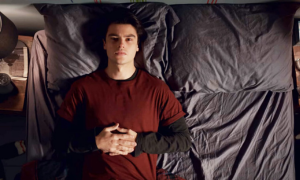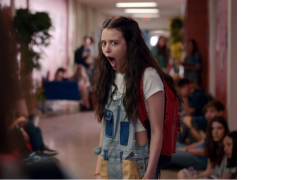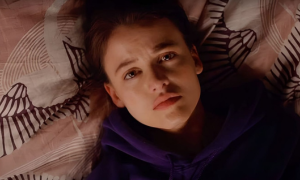
Jun 16 2025.
views 13By Rihaab Mowlana

A Mental Health Story That Almost Went Unnoticed
We’ve gotten better at talking about mental health, or so we tell ourselves. We post the infographics. We know what a panic attack looks like in theory. We’re comfortable using words like “trauma” and “trigger,” at least when there’s a trending hashtag to anchor them to. And in pop culture, we’ve started to see more visible portrayals of mental health struggles: characters going to therapy, having breakdowns, naming their pain.
So when Ginny & Georgia Season 3 dropped, I expected Marcus’ spiral. From the very first episode, he’s been carrying the weight of depression in a way that’s familiar - withdrawn, numb, drinking more, slowly unravelling. He hits all the beats we’ve come to associate with someone in a bad place. We see it coming. We’re meant to.

Marcus in Ginny & Georgia
Image: Netflix
But Maxine? We don’t see her coming. And that’s what makes her storyline feel like a punch to the gut.
There are no big scenes with Max. No sudden collapse. No desperate cry for help. She doesn’t stop showing up. She doesn’t self-sabotage in visible ways. She just… dims. Bit by bit, in a way that’s almost imperceptible, until you go back and realise she was cracking all along.
Max is the one who’s always okay. Or at least, she knows how to act like she is. She’s loud, expressive, funny. The type of friend who turns every moment into a performance, every gathering into a stage. She’s the one who distracts from awkward silences, who picks up the energy when the room gets too heavy. She’s also the twin who isn’t spiralling, which means no one thinks to check on her. Her parents are too focused on Marcus to see how his pain is bleeding into hers. Her friends are too used to her being the helper to imagine she might need help. And Max herself? She plays her part like a pro.

Maxine in Ginny & Georgia season 3
Image: Netflix
It’s a dynamic that’s uncomfortably familiar to so many of us. In every friend group, there’s someone like Max. The glue. The planner. The one who checks in, who sends voice notes, who says, “Let me know if you need anything,” and actually means it. The one who holds it together for everyone else. And the longer you play that role, the harder it becomes to admit that you’re struggling too.
We don’t talk enough about this kind of suffering, the kind that hides in plain sight. The kind that doesn’t disrupt or demand attention. The kind that smiles. That makes jokes. That shows up to the group hang and brings snacks, and says, “I’m good!” when they’re anything but.
Maxine’s storyline shines a light on the invisible struggler: the person who is functionally unwell. The friend who’s drowning behind a calendar full of obligations. The one who performs joy so convincingly that even they start to believe the performance. This isn’t the mental health narrative we’re used to seeing, not in media, and certainly not in real life. But it’s real. And for some of us, it’s the only version we’ve ever known.
In Sri Lanka, especially, this kind of struggle gets misread all the time. If you’re not crying in bed or showing outward signs of distress, your pain is often dismissed. You’re seen as “strong,” “resilient,” “dramatic, but she’ll be fine.” We make space for breakdowns only when they’re visible. We don’t know what to do with the person who’s falling apart while still functioning.
Max’s pain isn’t palatable. It’s not framed neatly. It’s messy in a quiet, confusing way. And what makes it even more tragic is that her own support system — her family, her closest friends — don’t even clock it. Because her performance of wellness is too convincing. Because she’s been taught that her role is to hold others up, not fall down herself.
There’s something deeply gendered about this, too. Marcus is given room to collapse. He spirals, and it’s seen as serious. Urgent. Heartbreaking. Max is expected to cope. To take on the emotional labour. To be the twin who doesn’t need watching. And when she starts to crumble, no one sees it. Because they’ve all already decided she’s “fine.”
And isn’t that the case so often? We believe what’s easiest to believe. If someone looks okay, sounds okay, functions okay, we accept it. We’re uncomfortable digging deeper. We don’t ask twice.
But here’s what Max’s arc reminds us: not all broken looks broken. Sometimes it looks like overcompensating. Sometimes it looks like being the life of the party. Sometimes it looks like showing up with cupcakes and cracking jokes and keeping the mood light, because the alternative feels too heavy to bear.
It’s a different kind of suffering. And it deserves to be taken seriously.
What Ginny & Georgia gets right is that it doesn’t turn Max’s storyline into a big dramatic spectacle. It doesn’t give her a “moment.” And that’s exactly why it hits so hard, because real life isn’t always made up of big scenes. Real pain is often quiet. Hidden. Easy to overlook. Especially when it comes from the people we least expect.

Maxine in Ginny & Georgia season 3
Image: Netflix
So what do we do with that?
We stop waiting for people to fall apart in ways that are comfortable for us to see. We stop assuming that the loudest pain is the most urgent. We stop rewarding people for being “low-maintenance” and start recognising that just because someone is functioning doesn’t mean they’re okay.
We check on the friend who always shows up. We ask how they’re doing, and then ask again when they brush it off. We pay attention to the people who perform happiness a little too well. Because sometimes, that’s the only way they know how to ask for help.
Maxine’s breakdown doesn’t come with fireworks. But that doesn’t make it any less real. And in a world that loves spectacle, maybe it’s time we paid more attention to the quiet unravelings. The ones that don’t make noise. The ones that hide behind a laugh. The ones that never ask for attention, but desperately need it.
Because some people don’t collapse.
They carry.
And carry.
And carry.
Until they can’t.
0 Comments